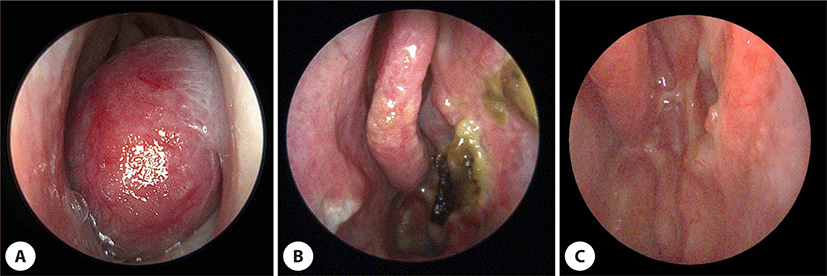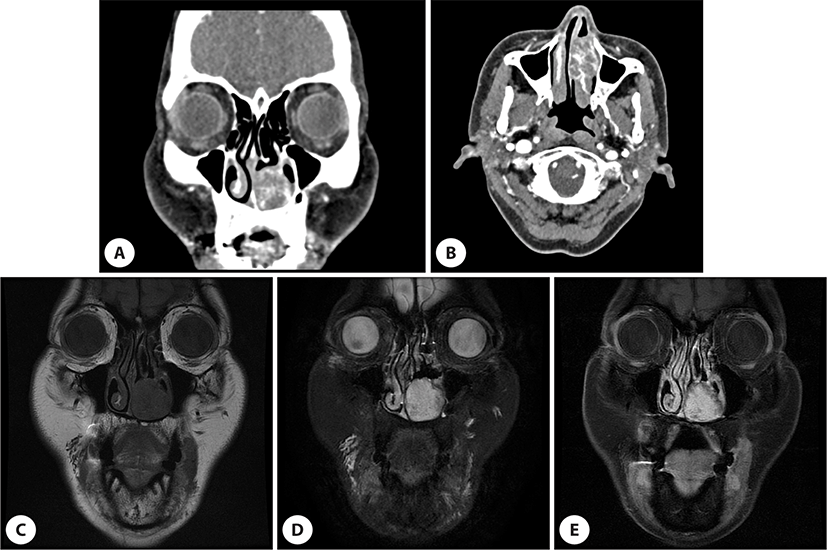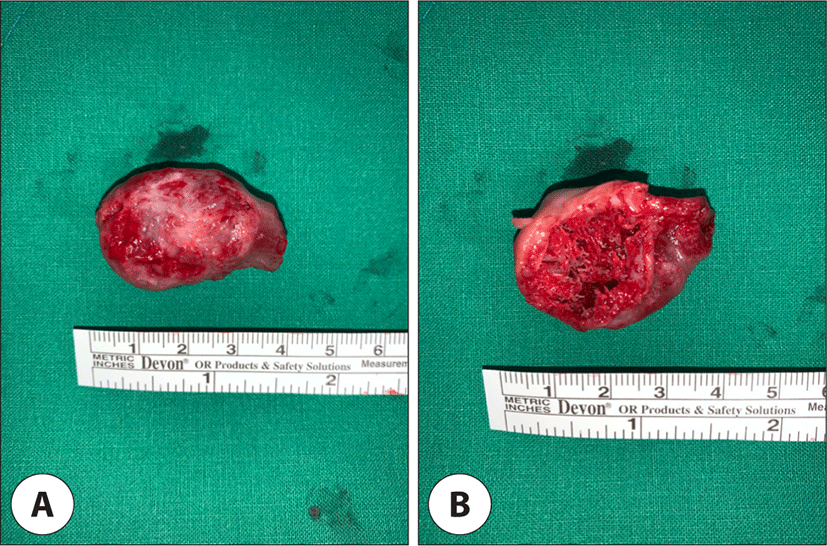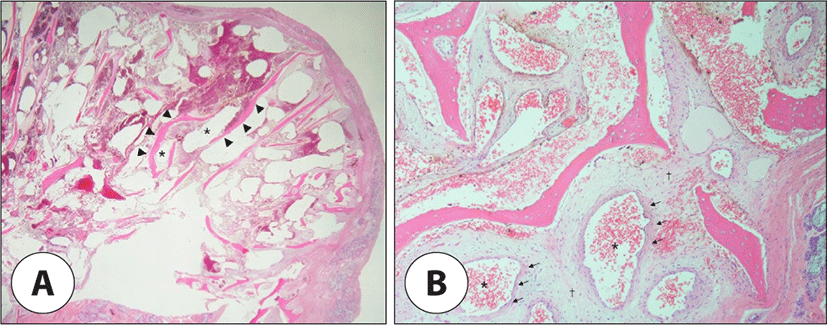서론
혈관종은 비정상적인 혈관 내피세포의 증식으로 나타난 양성종양이다. 병리소견에 따라 모세혈관성, 해면성, 혼합성으로 구분되며 두경부에 가장 많이 발생하고 체간부, 사지 순으로 호발한다.1,2) 병리학적으로 해면성을 나타내는 골내 혈관종의 경우 전체 골 종양의 1% 미만을 차지하며 비골에서 발생한 혈관종은 극히 드물다.3) 비강 내의 모든 위치에서 양성종양이 발생할 수 있지만 호발하는 부위는 비강 측벽, 사골동, 상악동으로 하비갑개 기원은 드물다.4) 국내에서는 비강기원 골내 혈관종이 7건이 보고5–11)되었으며, 하비갑개 기원 골내 혈관종은 국내의 경우 2021년도 1건,9) 국외의 경우 5건이2–4,12,13) 보고되었다.
특히 이번 증례는 6년 전 혈관종 절제술 후 재발한 증례로 재발 방지를 위한 치료법은 안전영역을 확보한 완전 절제술이 필요하다는 것을 입증한다. 이에 저자들은 재발한 증례의 하비갑개 기원 골내 혈관종을 보고하며 여러 문헌고찰과 함께 국내와 국외 보고를 비교하여 유사성 및 경향성을 보고하고자 한다.
증례
60세 여자 환자가 2년 동안 지속된 좌측 코막힘으로 내원하였다. 동반된 증상으로는 재채기, 맑은 콧물, 후비루가 있었고 알레르기 피부반응검사에서는 음성으로 확인되었다. 혈관종 절제술을 시행하기 두 달 전부터 좌측 코 통증과 좌측 안구통증이 생겼고 심해지는 양상이었다. 잦은 코피, 코 패킹, 얼굴 외상력은 없었으나 이전에도 지속된 좌측 코막힘으로 타 병원에서 2014년 좌측 하비갑개의 종양 절제술을 받았다. 당시 조직학적 진단은 해면성 혈관종이었다. 비내시경상 우측으로 치우친 비중격 만곡증이 있었으며, 좌측 비강 입구에서 딱딱한 종괴(Fig. 1A)가 확인되었고, 보스민 거즈 패킹에도 쪼그라들지 않는 양상을 나타내었다. 컴퓨터단층촬영상 좌측 하비갑개에서 3.0 cm의 뚜렷하게 혈관구조에 조영 증가되는 종괴(Fig. 2A, B)가 확인되었고 혈관종이 의심되었다. 자기공명검사에서 좌측 하비갑개에서 2.3 cm 크기의 연부조직 종괴가 확인되었으며 T2WI에서 강한 신호강도를 보이고 내부로는 약한 신호강도가 관찰되었다(Fig. 2C, D).


좌측 하비갑개 전체가 종양성 변화를 보였고 전신 마취하 내시경적으로 절제하였다. 3×4 cm 크기의 종괴는 정상 점막조직으로 둘러 쌓여 있었고 내부는 딱딱한 골 구조로 채워져 있었다(Fig. 3). 수술과정 중 경미한 정도의 출혈소견이 보였고 절제 부위는 SurgicelⓇ, NasoporeⓇ로 패킹을 시행하였다. 현미경적 소견으로 종괴는 골 소주(bony trabeculae)와 해면상의 혈관구조물이 보였으며, 조직학적 진단은 하비갑개에서 기원한 골내 혈관종으로 확인되었다(Fig. 4).


술 후 한 달째, 수술 부위는 약간의 딱지 외 양호하였으며, 술 후 6개월 째 확인 시 수술부위는 잘 나았으며 재발소견은 없었다(Fig. 1B, C). 2년 6개월간 경과 확인 시, 좌측 코 안의 약간의 건조함이 있으나 재발소견은 없이 양호한 상태로 추적관찰을 종료하였다.
고찰
혈관종은 비정상적인 혈관 내피세포의 증식으로 나타난 양성종양으로 반수 이상이 두경부에 나타나고 코의 침범은 드물다.3) 호발 연령은 40대로, 여자 대 남자의 비율은 3 대 1이고 좌측에 주로 발생하며 이전의 외상병력과 관련이 있다.1,13) 병리학적으로 해면성을 나타내는 골내 혈관종은2) 골 종양의 1% 미만을 차지하고 이마저도 척주와 두개골에 잘 발생한다는 점을 고려해보면 비강의 골 기원 혈관종은 극히 드물다는 것을 추론할 수 있다.1,4)
컴퓨터단층촬영은 가장 유용한 영상검사로 골 소주(trabecular)와 골 피질(cortical)이 두드러지게 보이나 다양한 영상소견을 나타낸다.가장 흔하게 보이는 형태는 방사형의 골 소주가 태양광처럼 뻗어가며 종괴 내부는 전형적으로 비누거품 혹은 벌집 모양의 소견으로 나타난다.14) 자기공명영상에서 골내 혈관종은 정맥혈의 양, 함유하고 있는 지방함량에 따라 신호강도가 결정된다. T1 강조 영상에서 저강도 신호를 보이나 간혹 작은 병변에서 고강도 신호를 보일 수도 있다.14) 본 증례의 경우 컴퓨터단층촬영에서 방사형으로 뻗어나가는 골 소주(trabeculae)와 비누거품(soap bubble) 형태의 내부 음영이(Fig. 2A, B) 보였고, 자기공명영상에서 T1 강조영상에서 왼쪽 하비갑개에 저강도 신호를 보이며, gadolinium enhanced fat suppressed T1 강조영상에서 대부분 조영증강이 되지만 내부와 가쪽으로 저강도를 보이는 부분이 혼재되어 나타났다(Fig. 2C, E). 섬유이형성증, 골화성섬유종, 골종, 골육종, 랑게르한스세포 조직구증식증, 다발골수종과 감별이 필요하며,7) 본 증례의 경우 술 후 조직검사결과에서 골내 혈관종으로 확인되었다.
보고된 국내의 증례를 요약하여 Table 1에 정리하였다.5–11) 비강 내 골내 혈관종은 총 8건으로, 원발 위치는 상악동 2건, 중비갑개 3건, 비중격 1건, 비배부 1건, 하비갑개 1건이었다. 증상으로는 비폐색이 50%였고 그 외에 우연히 발견되거나 외비 변형, 두통을 보였다. 방향은 우측 37.5%, 좌측 37.5%, 단일 부분 25%이었으며 남자 대 여자 비율은 약 1 대 2로, 평균 나이는 41.6세로 나타났다. 국내 증례들의 치료는 대부분의 경우가 비내시경을 통한 절제를 시행하였고, 1건은 비 배부에 위치한 해부학적 특성으로 외비 성형술의 접근법으로 수술을 시행하였다. 국내외 보고된 하비갑개 기원의 골내 혈관종 증례를 요약하여 Table 2에 정리하였으며,2–4,12,13) 하비갑개 기원인 경우 크기가 작았던 경우를(5 mm) 제외하고 모두 비폐색 증상을 호소하였다. 여성에게 주로 발생하였으며 평균연령 45.5세를 보였고 접근방식은 달랐으나 종양에 대한 절제를 시행하였다. 아직 증례가 많지 않아 국외 및 국내의 경향성과 인종적, 환경적 차이를 비교할 수 없지만, 현재까지 보고된 증례를 통합하여 보면 국내외에 보고된 예들 간의 경향성에 큰 차이가 없는 것을 알 수 있다.
| Reference | Sex/age | Symptom | Location | Treatment | Medical history |
|---|---|---|---|---|---|
| Kim et al.6) | M/55 | Nasal obstruction both, Lt frequency epistaxis, PND | Lt mid turbinate | Excision via endoscope | - |
| F/27 | Lt frontal headache | Lt mid turbinate | Excision via endoscope | - | |
| Kim et al.7) | F/52 | Incidentally found | Lt mid turbinate | Excision via endoscope | HTN |
| Hwang et al.8) | F/9 | Nasal obstruction Rt | Rt maxillary inferomedial wall | Excision via endoscope | - |
| Kim et al.9) | M/63 | Painless mass External nasal deformation | Nasal dorsum | Open rhinoplasty approach | - |
| Park et al.10) | F/53 | Incidentally found | Nasal septum | Excision via endoscope | None |
| Jung et al.11) | F/31 | Nasal obstruction Rt | Rt maxilla bone | Excision via endoscope Nasal packing→angiography embolization Excision via gingivobuccal incision | - |
| Heo et al.5) | M/43 | Nasal obstruction Rt | Rt inferior turbinate | Endoscopic submucosal incision Debulking using microdebrider | None |
| Reference | Sex/age | Symptom | Location | Physical exam | Treatment |
|---|---|---|---|---|---|
| Fahmy et al.12) | M/23 | Nasal obstruction both | Rt inferior turbinate | Rt inferior turbinate hypertrophy Nasal septum deflected to Lt | Excision via midfacial degloving approach |
| Takeda et al.4) | F/73 | Nasal obstruction Lt | Lt inferior turbinate | Lt inferior turbinate hypertrophy Mass obstructing the Lt nasal cavity | Excision via Caldwell-Luc procedure |
| Akiner et al.3) | F/57 | Nasal obstruction Lt | Lt inferior turbinate | Mass origination from inferior turbinate | Excision via endoscope |
| Sarkar et al.13) | F/30 | Hemoptysis, hematemesis | Posterosuperior part of inferior turbinate | Small mass found in the postero-superior part of inferior turbinate (near the post fontanelle of the maxillary antrum) | Excision via endoscope |
| Goomany et al.2) | F/47 | Nasal obstruction Lt | Lt inferior turbinate | Lt inferior turbinate hypertrophy | Excision via endoscope |
| Heo et al.5) | M/43 | Nasal obstruction Rt | Rt inferior turbinate | Mass obstructing the Rt nasal cavity | Endoscopic submucosal excision Debulking using Microdebrider |
현재 혈관종의 치료방법은 수술적 절제이다. 절제할 수 없는 병변에 대하여 방사선치료가 고려되지만 장기적인 효과를 고려하였을 때 안전영역(safety margin)을 확보한 광범위 절제만이 확실한 치료방법이다.2,4) 절제방법은 내시경수술 발전 이전에는 비외 접근법을 하였으나 현재는 내시경을 이용한 방법이 선호되며1,4,15) 대부분 광범위 절제를 한 것을 알 수 있다(Table 1, 2). 혈관종은 안전영역을 확보한 광범위 절제를 하게 되면 재발이 거의 없는 것으로 알려져 있다.2,4,15) 이전 상악골 기원 골내 혈관종의 증례는 소아환자로, 광범위 절제술의 부담이 있어 큐렛으로 긁어내는 불완전 절제를 시행하였으며 3년 후 재발하였다.15) 본 증례도 2014년 하비갑개 일부만 절제하였으며 6년 후 재발하여 재수술을 받았다. 2021년 국내에서 처음 보고된 증례도 점막하 절제 후 microdebrider를 이용한 debulking하였으며, 1년간 추적관찰 시 재발의 소견은 없었다고 하나,5) 향후 재발의 가능성을 배제할 수는 없을 것으로 판단되며 장기적으로 재발하지 않는지 충분한 기간 동안의 추적관찰이 필요하다. 하비갑개 완전 절제는 빈 코 증후군(empty nose syndrome)이 발생할 수 있으나 본 증례 환자는 일부의 건조함 외에 다른 불편감은 없었다.
국내외 하비갑개기원 골내 혈관종 6건의 경우, 거의 유사한 증상과 발병나이대를 보였으며, 국내외 13건의 골내 혈관종의 경우에도 서로 비슷한 경향성을 보였다. 본 증례를 통해 하비갑개 골내 혈관종, 특히 이전의 불완전 절제로 인해 재발한 증례에 대해 논의하였다. 골내 혈관종의 치료 시에는 재발을 예방하기 위한 완전 절제가 중요하며 충분한 기간 동안의 추적관찰이 필요함을 알 수 있었다.






